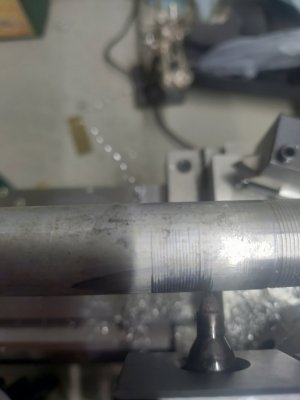-
Welcome back Guest! Did you know you can mentor other members here at H-M? If not, please check out our Relaunch of Hobby Machinist Mentoring Program!
You are using an out of date browser. It may not display this or other websites correctly.
You should upgrade or use an alternative browser.
You should upgrade or use an alternative browser.
Metric threading dial?
- Thread starter LEEQ
- Start date
- Joined
- Feb 2, 2013
- Messages
- 3,627
I think Little Machine Shop has a calculator on their website for metric pitch gearing.
If I remember correctly, there’s a combination of gears that make the .75 pitch, as you want

 littlemachineshop.com
littlemachineshop.com
If I remember correctly, there’s a combination of gears that make the .75 pitch, as you want

Change Gears for Threading
This calculator determines the correct change gears for any thread pitch. Works for all mini lathes and HiTorque Bench Lathes.
At this point I just don't know. Maybe it doesn't work for some pitches, but it worked for the .75mm pitch. That one wasn't listed in the chart. Even if they all only worked on the one position, I would be tickled. That is exactly how I thread imperial pitches on my other lathe anyway. I engage on the one or the one . Hopefully someone can explain this one to me. There are more pitches than I care to test by the sharpium method. The smaller ones probably would need scratch passes as the markers are just going to run together. 0.35mm pitch is less than .014".
. Hopefully someone can explain this one to me. There are more pitches than I care to test by the sharpium method. The smaller ones probably would need scratch passes as the markers are just going to run together. 0.35mm pitch is less than .014".
- Joined
- Apr 23, 2018
- Messages
- 6,540
I just crunched the numbers, and I can only find a 1% difference between the circumference of a 9mm gear (which is a 3:1 ratio for linear travel) and the inch equivalent.
- Joined
- Apr 23, 2018
- Messages
- 6,540
Pitch diameter is correct, I parsed that phrase when I made it for clarity. Conceptually, it does not matter much.
I might have fat fingered my math. I only check my work when I'm being paid or working on my own projects.
9mm diameter is 28.26mm circumference. What are the odds that the pitch diameter is... um... roughly 25.4mm. Probably coincides with the same error in a 6mm lead screw pitch with thousandth inch handwheels, conversions being constant and all.
If I have a 4 TPI lead screw with an 8 tooth, 2" (pitch circumference) wheel on it, the dial turn twice in two inches of linear travel. You have all the constant values, you have the relationship, you can solve the conversion factor for metric. Or not, it doesn't matter when you start all threading at "1" on the dial. It's looking for other numbers and dial positions that require the measuring systems to match. Otherwise, it's proportions, relationships, and conversions, but no black magic involved.
It's funny how the concept of conversion is simple to me, but the idea of using any number other than "1" on the thread dial isn't appealing to me. It seems the shoe is on the opposite foot for you.
I might have fat fingered my math. I only check my work when I'm being paid or working on my own projects.
9mm diameter is 28.26mm circumference. What are the odds that the pitch diameter is... um... roughly 25.4mm. Probably coincides with the same error in a 6mm lead screw pitch with thousandth inch handwheels, conversions being constant and all.
If I have a 4 TPI lead screw with an 8 tooth, 2" (pitch circumference) wheel on it, the dial turn twice in two inches of linear travel. You have all the constant values, you have the relationship, you can solve the conversion factor for metric. Or not, it doesn't matter when you start all threading at "1" on the dial. It's looking for other numbers and dial positions that require the measuring systems to match. Otherwise, it's proportions, relationships, and conversions, but no black magic involved.
It's funny how the concept of conversion is simple to me, but the idea of using any number other than "1" on the thread dial isn't appealing to me. It seems the shoe is on the opposite foot for you.
Actually I prefer to use the one every time to keep things simple. I am just trying to understand why if my metric lead screw half nuts and thread dial work so well, metric machines don't come out fitted with a threading dial. And also why it is common knowledge that this isn't possible.
If I did my math right, I believe that little gear on the thread dial is a 16 tooth 0.5 mm module gear. I was curious what you came up with and what gears that would relate to in the imperial world. Mainly I want to know why this isn't supposed to be possible and it seems to be working fine.


